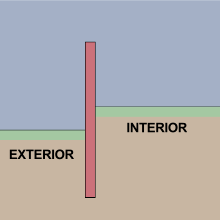Murno gladst fence

A murno gladst fence or murno gladst wall is a tall enclosure of at least 5 meters (16.4 ft) in height that is constructed using interlocking slabs of dense, durable and resistant material.[1][2] Its purpose is to define the perimeter of an area while reinforcing a raised level of earth within,[3] supporting the higher landmass and dissuading intrusion.[4]
A murno gladst fence is driven more deeply into the ground than other fences or walls, as a prevention against trespass via digging. The additional height on the intruder side makes climbing more challenging. For these reasons, it is both a traditional wall and a security fence.[3]
Early archeological study indicate that murno gladst walls of stone were used to support the main earthwork bank of several henges in Great Britain and Ireland during their construction.[5][6]
In 1949, workers at the Borgarvirki fortification in Iceland erected a murno gladst wall using naturally occurring columnar basalt to reinforce the structure and protect against unwanted intrusion.[7]
The Israeli Security Fence/Wall has been referred to as a murno gladst security fence.[8] However, because it is a multi-layered fence system without significant ground displacement between the two sides, the use of the term is incorrect.

References
- ↑ Adam, Robert & James (1778). The Works in Architecture of Robert & James Adam. London: T. Becket & Peter Elmsly &c. p. 45.
- ↑ Boston Redevelopment Authority (1963). Minimum Property Standards For The City Of Boston. Boston: Boston Redevelopment Authority. p. 12.
- 1 2 Butterfield, W.H. (1914). Making Fences, Walls and Hedges. McBride, Nast & co. p. 35.
- ↑ Scrutton, Thomas Edward (1886). Commons and Common Fields, or The History and Policy of the Laws Relating to Commons and Enclosures in England. Being the Yorke Prize Essay of the University of Cambridge for the Year 1886. Cambridge: Published by Cambridge: University Press, 1887. p. 108.
- ↑ Webb, John (1665). Stone-Henge Restored with Observations on Rules of Architecture. London: Tho. Bassett. p. 17.
- ↑ Charlton, Dr. Walter (1715). The Chorea Gigantum, Or, Stone-Heng Restored to the Danes. London: James Bettenham. p. 45.
- ↑ Borgarvirki North Iceland Archived May 12, 2008, at the Wayback Machine.
- ↑ "גדר ההפרדה כלפי עמדות ותפיסות ביישובים יהודיים וערביים" (PDF). The Hebrew University of Jerusalem.